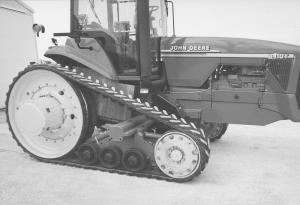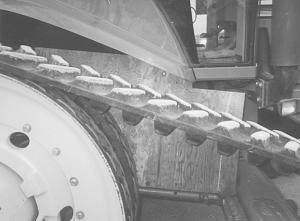2002 - Volume #26, Issue #2, Page #18
[ Sample Stories From This Issue | List of All Stories In This Issue | Print this story
| Read this issue]
Deere Tracked Tractor Fitted With Trash Shield
 |
 |
"It's great for tillage and general farm work, but when you move the tracks to their narrowest setting, crop residue builds up along the tractor frame near the muffler," he says. "This doesn't seem to be a problem with wider tracks, but since our 16-in. tracks are the same width as the drive wheels, crop residue gets pinched between the track and wheel as it comes around at the bottom. Where the track and wheel separate at the top, the trash drops off and makes a pile. The pile forms right next to where the muffler runs up along the cab."
Brown found himself stopping often to clean out corn stalks. Then he heard that another farmer with an 8140T lost his tractor to a fire.
So he contacted his dealer to see what could be done to prevent the problem. "I had an idea on how to make a shield that would deflect the stalks," he says. "I called Deere engineers to see if they had already put something together."
He was presented with a couple of ideas. "The first shields they sent out were rubber belts that mounted on the idler wheels. They worked fine when they were there, but every time I turned, the track chewed off a piece of them. They only lasted a couple of days," he says.
The second shields were made of steel. "They sent the blueprints for them to the dealer and the dealer had them made in a local metal shop. When they brought them out, they were too heavy to handle easily and then we couldn't figure out how to mount them on the tractor. I sent them back," Brown tells.
Convinced his original idea was better, Brown made his own shields. "I was going to make them out of heavy polyethylene, but decided to try plywood first to make sure the idea works," he says.
Before putting them together, he first decided how he was going to mount them on the tractor. When he'd finished building them, they fit just right and worked great.
"My design goes under the top of the belt and down 45 degrees from the fender toward the axle," he explains. "It catches most of the residue and deflects it down, so it doesn't drop on the frame. You still get a little buildup, but not enough to cause a problem."
Brown figures other farmers with 16 in. belts on their 8410T's may have the same problem. "I'm applying for a patent on my design and if enough people are interested, I'll make them for sale," he says.
He figures they could be molded in one piece from a rugged plastic material. "I'm not sure what they might cost at this time, but I think we could get them manufactured for less than the cost of the steel ones the Deere people designed," he says.
Contact: FARM SHOW Followup, Jason Brown, 473 Brown Road, Winchester, Ill. 62694 (ph 217 742-5242; E-mail: chiefs@wincoinet.com).

Click here to download page story appeared in.

Click here to read entire issue
To read the rest of this story, download this issue below or click here to register with your account number.




